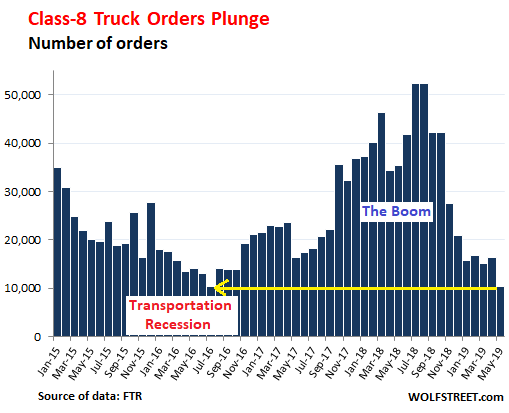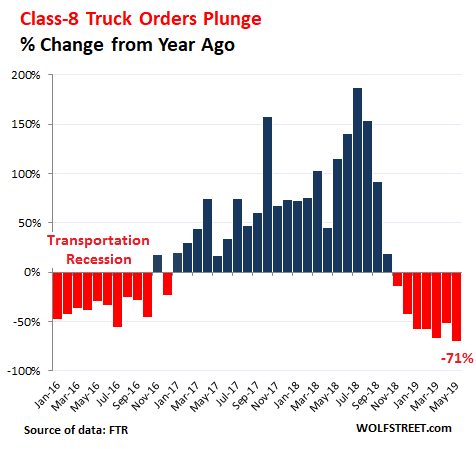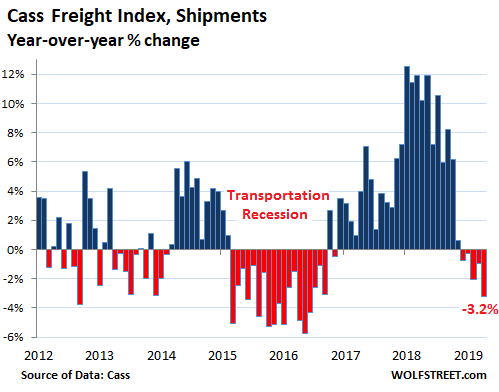“When times are tough, the thinking switches to the short-term. Many fleets are just fighting for survival.”
Orders for Class-8 trucks – the heavy trucks that haul a large part of the goods-based economy across the US – plunged by 71% in May compared to May last year, to — as FTR Transportation Intelligence called it this afternoon — a “chilly 10,400” orders. It was “the lowest volume for Class 8 orders since July 2016 and the weakest month of May since 2009,” FTR said in the statement (data via FTR):

This comes after orders had already plunged year-over-year by 52% in April, 67% in March, 58% in February and January, and 43% in December. It was the seventh month in a row of year-over-year declines (data via FTR):

The cyclical nature of the industry is legendary. Trucking companies get exuberant when capacity tightens and freight rates soar – which they did in late 2017, that in 2018 turned into an outright capacity shortage and a driver shortage.
This boom was fueled in part by a decision in Corporate America to build up inventories in the US to front-run potential import tariffs. This put additional pressure on trucking capacity, and on freight rates. And it motivated trucking companies to order new equipment to meet demand. Given the capacity pressure at the time, they tried to get the orders in ahead of the others, and this created a phenomenal boom in orders — and at truck manufacturers, historic order backlogs.
Then the other part of the cycle begins. As these new trucks enter service, capacity rises, taking pressure of the system. This was expected.
But then the unexpected happened: Demand backed off late last year. And April was the fifth month in a row of falling freight shipment volume in the US across all modes of transportation – by truck, rail, air, and barge – according to the Cass Freight Index, the first series of declines since the transportation recession of 2015 and 2016:

Craig Fuller, CEO at FreightWaves, wrote in an editorial about the duality currently in the market: Contract rates are barely hanging on, and large trucking fleets with big committed customers are able to benefit from those; but spot rates, on which smaller trucking companies are dependent, “have dropped like a rock” – by 36% from the peak in June 2018:
The reason – the market has been oversupplied with capacity. Carriers, big and small, added to their fleet counts last year. While carriers struggled to find drivers to seat those trucks, higher driver pay and incentives did generate successful outcomes.
The “driver shortage” and “capacity shortage” are two different things. The driver shortage commonly refers to the availability of drivers in the market to drive the trucks that are on fleet rosters, while the capacity shortage is a function of having enough trucks available for dispatch.
Unseated trucks don’t generate revenue, while a capacity shortage gives the fleets pricing power as shippers and brokers struggle to find capacity. And in markets with a capacity shortage, carriers and drivers alike are big winners. Nothing brings driver pay up like a good old capacity shortage.
When times are good, carriers are eager to grow their fleets and attract the best drivers, which means they roll out the best perks and incentives to get the drivers to join their fleet.
When times are tough, the thinking switches to the short-term. Many fleets are just fighting for survival.
And truckers are adjusting their orders for new equipment. At the moment, the historic backlog of Class-8 orders that accumulated during the boom in 2018 is keeping truck manufacturers on their toes.
But during the transportation recession, Paccar (Peterbilt and Kenworth), Navistar International, Daimler (Freightliner and Western Star), and Volvo Group (Mack Trucks and Volvo Trucks) and their suppliers, such as diesel-engine manufacturer Cummins, laid off waves of workers. But for now, this is not on the horizon.
The backlog is expected to shrink to about 220,000 orders, which will keep build rates “at robust levels,” FTR said in the statement today. This is down to nearly half of the record backlog of 411,000 orders at the peak last summer, according to FTR at the time.
May was the last month of the order cycle. And in June, some manufacturers will start taking orders for next year. And that will be the moment of truth.
“The economy and freight growth are expected to ease throughout the year, applying some downward pressure on the truck market in the second half,” said Don Ake, FTR vice president of commercial vehicles. “Orders for the next couple of months should be a good indicator of fleet confidence about 2020.”
Weakness in the transportation sector deepens and volume declines. Read… Trucking & Rail Shipments Sink as US Goods-Based Sector Slows
Enjoy reading WOLF STREET and want to support it? You can donate. I appreciate it immensely. Click on the mug to find out how:
![]()


It was a shorter than normal boom your tariff front run analysis is probably very accurate.
will we see a dumping of late life trucks before their normal end life markers to seek tax advantage end this tax cycle as many operators are now overstocked with new and medium life units?
Which will reduce demand for New units further in class 8.
A Base Fundamental
This current collapse of class 8 truck orders,is just another fundamental piece of the downward spiral, in global economic trade.
We are in a recession that began with the mini crash of December and is creeping along ever deeper.
All the central banks economic fiscal/monetary ‘hocus pokus’ will not be able to fix it.
During the global 1998 LTCM fiasco, it was the Wall street banks that rode to the rescue. Then in 2008 it was these same Wall street banks that required rescuing.
Next up is the sovereign’s them self’s that must be rescued.
Just think about that for a while. How are all the deeply indebted countries of the world, going to rescued?
When all peaceful avenues fail? Take the nation to WAR.
That’s why there’s only one party in America-
The War Party Of The Rich.
Like a lot of people in Appalachia my family has been feeding the empire since the Spanish American war ,ditto for me. My dad a marine in the 6th Division survived Okinawa(2 landings) and Tinnan and Saipan. He talked my son out of joining before he died , my sons mother is forever thankful that he did..No more cannon fodder for the empire was his message. What does sagging truck sales have to do with this? Everything ,on my rung of the economic ladder.
Just like all the deeply indebted countries in past history were “rescued”….slowly with inflation, or rapidly with issuance of a “new” currency.
imagine finding a 1900 $20 gold coin in your grandfathers attic. Imagine how many friends you could have taken out for dinner in 1920,, then imagine how much that same $20 buys today. Imagine how much gold you could buy in 1920, if you could take $1335 of today’s dollars and go back in time to 1920.
This is how debt is handled. The trick is to make it as gradual as possible. Right now the news media is telling us about the strength of the dollar. Really, relative to what, other paper currencies?
In 1900 you could get a very good dinner at a good NYC restaurant for 75 cents. Twenty dollars would have bought about 27 such. Today the gold would sell for about $1325. Divided by 27 that’s $49, much less than you’d pay for such a dinner today. The equivalent of a $49 meal in 1900 in other parts of the country was probably about 50 cents. You could have bought 40 with your gold piece.
I think you might have missed my point. I was asking how many people you could take to dinner today for $20….not even two.
It’s Japanification without the savings rate. We can feel good about ourselves by saying we are the cleanest shirt with elephant dung smeared all over it.
“We are in a recession that began with the mini crash of December and is creeping along ever deeper.”
Interesting point you make. I am seeing some small and micro caps get some merciless beatings in the specialty retail space over the last few weeks. Clothing, furniture etc. Not looking like a normal sell off this time.
Obviously this would be a more reliable recession signal back in 2007-08 than today as now we have the formidable online shopping space.
Regardless, it will leave a fair share of pain in it’s wake soon enough.
I think most of the “bad” news nowadays are caused by the Feds drive towards NORMALIZATION. When they tried to remove the punch bowl, the economy started to show cracks. We’re addicted to very low rates and historical standards and theory are having a hard time making enough sense. It has been a fairy tale for more than a decade.
Does the Cass Freight Index include goods being moved by the ever-growing armada of Amazon trucks?
It tracks what shippers (retailers, industrial companies, etc.) are paying for to get their goods shipped to their customers. The data is based on invoicing by Cass clients for all modes of transportation in the US. Cass processes about $20 billion in freight invoicing a year. So this is a very large sample of the shipping market, by far the largest sample out there. But it doesn’t track every single dollar spent by anyone and everyone who ever ships anything whatsoever in the US.
If everybody bought a new truck in 2018, it would seem to me you would not need to buy another one for several years, hence the boom in the curve is naturally followed by a bust. You see this same phenomenon in farming equipment, but the subsequent bust doesn’t mean consumers are going on a diet, or if the trend continues, stop eating altogether.
Off $ topic but truck driver related.
On my trip to town yesterday I saw a newly erected giant sign advertising for workers at Western Forest Products Menzies Bay Division. One of the classifications was log truck drivers. There were many others. I haven’t seen such a thing for years, this public advertising (picking off) workers who’re just driving by.
If you could make 100K a year and be home everynight as a driver…4 days on and 4 days off 12 hour shift…(day shift only) plus all benefits, why would you drive overland with all the restrictions and hassles? These are highway trucks, and not the big off road fat trucks working the more difficult terrain.
In town, (Campbell River BC) the truck service centres are bursting; Inland Kenworth, Bailey Western Star, and a few others. Busy busy busy.
The Piggot fish “camp” is nearby.
Apartb from off highway mining and fert spreading, logging is the most dangerous from of trucking.
After ten years and untold trillions of “stimulus” printed up to levitate their Ponzi markets and asset bubbles, the central bankers’ ability to defer the inevitable is weakening as each new jolt of financial crack cocaine produces less of a rush on strung-out stimulus-addicted markets, while underlying economic fundamentals continue to deteriorate.
The MSM is going all-out to lure the last of the retail-investor muppets into Wall Street’s rigged casino. Looks to me like a surefire indicator that the next Great Muppet Reaping is being set up.
Who floated the loans to buy these expensive Class 8 rigs? Did anyone short it?
Tariffs and counter-tariffs disrupt global trade. Trucking companies are part of trading goods and merchandise.
The US blacklisted Huawei. China plans to retaliate by blacklisting US companies.
China may become a rare earth element cartel raising prices.
China is dependent on semiconductor chips from outside China.
Our Transportation team does a TL bid every year and we will be seeing very nice reduction this year on the bid. Asset carriers and brokerage are hungry and rates have reduced compared to last year. We should see a nice reduction YOY. Regarding the number of calls I get daily from every form of logistics company is getting insane. I have had a ton of calls from China regarding air freight forwarding and ocean FCL / LCL. Some of them sound pretty desperate.
I drove by the front gate of Western Stars (Daimler) factory in Portland yesterday. There are three big finished goods parking lots where the trucks are staged as they leave the factory, awaiting delivery to customers. When the factory is busy ( like a year ago) all three lots are jam packed with trucks awaiting delivery, yesterday only one of them had new trucks in it. The Western Star Trucks are highly customized so each one is a special order so it is not like cars where they park finished goods waiting for a buyer. To me it represents a lower flow of trucks from the factory.
This is OFF topic but an important development.
For the first time since June 26, 2012, the FED has bought short term T-bills. They got rid of all their T-bills by August, 2012 so this is again the first time since then that the Fed will be buying T-bills. Although the amount is rather small, about $2,666,700 for 4 week and $2,333,300 for 8 week Treasuries, this is a sign of weird things to come. In 2012 era, and before that especially, people thought the world was coming to an end. Today, we have high stock prices, low unemployment and low inflation.
Who knows what the Fed is up to? But this isn’t a good sign.
The second point I was to bring up is the short-term interest rate (as exemplified by the 4 week). If I can recall, Title 2 of the Congressional authority given to the Fed to pay interest on reserves states that it should be LOWER than short term interest. Well, the 4 week has an investment interest rate of 2.332% and the 8 week 2.347%. That is LOWER not HIGHER than IOER or IOR which is 2.35% currently. What gives? Does the Fed have to obey Congress or the law?
Although trucking and shipping data used to be the harbinger of things to come, it seems that today all that matters is the low interest rate and liquidity. That keeps the party going.
The BIGGEST (and only really) problem facing US businesses are lack of available workers. Not taxes or sales — effective tax rates on business, and capital have never been lower, top line revenue growth is booming across the board as well — P/E ratios are actually falling as the stock market rises because the denominator is rising faster than the stock price.
First time jobless claims have been 225,000 this month and show no sign of turning up — if companies were fighting for survival they would be letting people go which in turn would be showing up in initial claims data.
In 1900 you could get a very good dinner at a good NYC restaurant for 75 cents. Twenty dollars would have bought about 27 such. Today the gold would sell for about $1325. Divided by 27 that’s $49, much less than you’d pay for such a dinner today. The equivalent of a $49 meal in 1900 in other parts of the country was probably about 50 cents. You could have bought 40 with your gold piece.